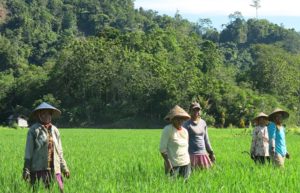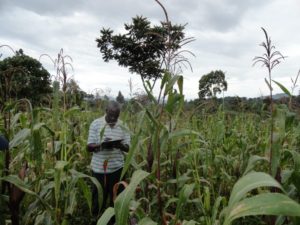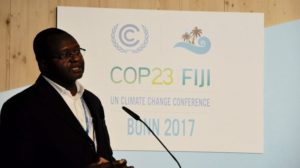
Growing more trees on agricultural land will help farmers and the world adapt to, and mitigate, climate change, something the world’s nations began to implement at the 23rd climate change conference as they brought agriculture onto the agenda.
In a groundbreaking — though long overdue — decision, national delegates at the 23rd Conference of the Parties of the United Nations Framework Convention on Climate Change (COP 23), held on Nov. 6–17, 2017, in Bonn, Germany, agreed on a framework for addressing agriculture’s impact on climate. The framework includes assessing soil health, soil carbon and water management, nutrient use and manure management, and the impact of climate change on socio-economics and food security.
Agriculture was also a key agenda item at the COP’s side events as international organizations, research institutions, governments, civil society and the private sector discussed initiatives needed to achieve countries’ climate targets for agriculture.
Scientists from the World Agroforestry Centre (ICRAF), including from the CGIAR Research Program on Forests, Trees and Agroforestry (FTA), presented research findings at several side events, highlighting the benefits that trees in agriculture, aka agroforestry, bring to the fight against climate change.
Read more: World Agroforestry Centre at the UN Climate Conference 2017 (COP23)
Agriculture Action Day
More than 30 countries have included climate-smart agriculture in their nationally determined contributions (NDCs) to reduce greenhouse-gas emissions, underscoring the potential of the approach to drive agricultural investments and programmes.
Tony Simons, ICRAF Director General, moderated an event for the Food and Agriculture Organization of the United Nations (FAO), titled, ‘Scaling up climate-smart agriculture to the NDCs in the agriculture sector’. Panellists discussed approaches to implement, scale-up and monitor the outcomes of climate-smart agriculture.
Simons reminded the audience that, ‘Trees made this planet habitable and their destruction will render it uninhabitable’. Growing trees in agricultural land, which is often a key feature of climate-smart agriculture, brings many benefits not only to farmers but also to the environment they inhabit.
Rima Al-Aza of FAO talked about the Climate-smart Agriculture Sourcebook, highlighting five new areas introduced in the second edition: 1) climate-change adaptation and mitigation; 2) integrated production systems; 3) supporting rural producers with knowledge; 4) role of gender in climate-smart agriculture; and 5) theory of change for climate-smart agriculture.
Bruce Campbell of the CGIAR Research Programme on Climate Change, Agriculture and Food Security discussed the importance of indicators to monitor and measure the outcomes of context-specific, climate-smart agricultural approaches.
At another session hosted by FAO, ‘Reducing the vulnerability of fragile ecosystems to climate change: the case of mountains and drylands’, panellists discussed their experience with implementation, lessons they learned and progress achieved in building climate-resilient systems.
Somaya O. Abdoun of Sudan presented the Forests National Corporation’s agroforestry-related projects for improvement of the productivity of gum arabic. Smallholders were reaping agroforestry benefits related to timber, energy and nitrogen fixation.
At the same session, Tony Simons explained the benefits that trees bring to ecosystems, including improving microclimates, fixing nitrogen, bringing up water from deep in the soil, sequestering carbon from the atmosphere, supporting biodiversity and adding oxygen to the biosphere. Trees also provide more diversified income and are a source of energy: 75% of on-farm biomass comes from trees. For example, in beginning in the 1990s, in Tigray, Ethiopia, a community successfully restored degraded land, so much so that rivers in the catchment continue to flow even during severe droughts that once saw all streams dry up.

Agriculture Advantage: the case for climate action in agriculture
Agriculture Advantage: the case for climate action in agriculture was a collaborative event between research, development and private organizations aimed at transforming agriculture in the face of climate change. The event sought to create a collective case for investment in agriculture and open avenues for extended partnerships to scale-up climate actions across wider areas of the planet.
Various sessions focused on maximizing the productive use of water; species that were more tolerant to drought, heat and pests; incentives to increase women’s participation in agriculture; finance for climate action; the interface between science and policy for programmes that deliver action on the ground; crop breeding for climate-resilient varieties; and the private sector as an agent for transformative change in the sector.
At the session, ‘Scaling-up private sector climate actions in agriculture’, Tony Simons called for the need to link public goods with private interest to increase investments in the agricultural sector. Engaging with the private sector would increase access to information for both farmers and the private sector, increase expertise and networks, create appropriate products and services suited to the agricultural sector, enable leveraging of joint investments, develop novel approaches to address complex challenges, enhance competencies in the sector, and accelerate the impact of agricultural initiatives. He highlighted Indonesia’s Tropical Landscape Finance Facility that is using public funding to unlock private finance in renewable energy and sustainable landscape management. The long-term goal is to reduce deforestation and restore degraded land.
Simons also called for people to combine the science of discovery with the science of delivery to ensure the future of the agricultural sector. Different expertise needs to come together to find solutions that will enable smallholders to increase their productivity while also protecting the environment.
Read more: FTA at COP23
Indonesia’s low-carbon development plan
Recognizing the impact of climate change will have on its economy, the government of Indonesia has taken steps to reduce greenhouse-gas emissions from different sectors while at the same time sustaining economic growth and maintaining ecosystem services. At a side event hosted by ICRAF and the Indonesian Government, experts discussed actions that can fast-track low-carbon development.
Sonya Dewi, ICRAF Indonesia program coordinator, presented a methodology called Land-use Planning for Multiple Environmental Services (LUMENS), which has been mandated by the Ministry for National Development Planning for use in all 34 provinces. LUMENS has been applied as a predictive tool that can analyse trade-offs for ‘green’ growth and other development scenarios. Using LUMENS, ICRAF has provided technical support for the development of South Sumatra Province’s green-growth strategy. This is Indonesia’s first master plan for renewables-driven green growth.
Land restoration, food systems and climate change
At a session hosted by WWF and TMG Think Tank, panellists discussed the impact of restoration of degraded land on food systems and climate. Soil restoration was seen as a multi-win strategy that can contribute to mitigation of climate change, strengthened food security and reduced pressure on natural habitats.
Alexander Müller, of TMG Think Tank and ICRAF Board member, called for better attention to soils given their finite nature, the inclusion of natural resources as capital in farming, and reduction in food waste as a trade-off.
Tony Simons outlined how the adoption of agroforestry can restore degraded land. He said that growing the right tree in the right place delivers economic benefits through tree products, including fruit, biomass, timber and medicines. Trees also deliver ecosystem services, such as carbon sequestration, improving soil fertility, preventing soil erosion, protecting watersheds, providing shade for both crops and animals, and supporting biodiversity.
Rights-based approaches and economic incentives were seen as the keys to success. Science has a major role to play in the global land restoration agenda and the agricultural targets in the climate agreement. ICRAF’s tools such as the Tree Finder and the Agroforestry Database can support this ambition.

Multisectoral process to NDC implementation in Peru
The Multisectoral Working Group, comprising Peru’s 13 ministries and the Centre of Strategic Planning, is working towards meeting the nation’s NDCs and sustainable development objectives. The group is exploring the potential of agriculture to contribute to the NDCs.
Valentina Robiglio, landscapes and climate-change scientist at ICRAF, discussed how agroforestry is being applied in Peru’s coffee and cocoa sectors. The most direct contribution of agroforestry to the NDCs is increase in soil carbon stock. Indirect contributions include improved cocoa and coffee production and silviculture on degraded land. She stressed that increased investments in improving tree germplasm and capacity building for farmers and extension workers were crucial for increasing the uptake of agroforestry.
FTA scientist Peter Minang, who leads ICRAF’s Greening Tree Crop Landscapes research theme and the ASB Partnership for the Tropical Forest Margins, presented a newly-released policy brief, How agroforestry propels achievement of nationally determined contributions. The brief explores the degree to which agroforestry is represented in NDCs, how its application is envisaged and how its contribution could be enhanced. He said that agroforestry requires a multi-sectoral approach because it involves both agriculture and forestry. He called for the use of public finance to catalyse investments and de-risk agroforestry to cushion private-sector investments.
Way forward
Building on initiatives highlighted during the side events, the research and development sectors have the opportunity to work with governments towards meeting targets set out in the agriculture framework of the Paris Agreement. This demands better coordination and collaboration and financing to realize the goals.
By Susan Onyango, originally published at ICRAF’s Agroforestry World.
The World Agroforestry Centre (ICRAF) is one of the 15 members of the CGIAR, a global partnership for a food-secure future. We thank all donors who support research in development through their contributions to the CGIAR Fund.








